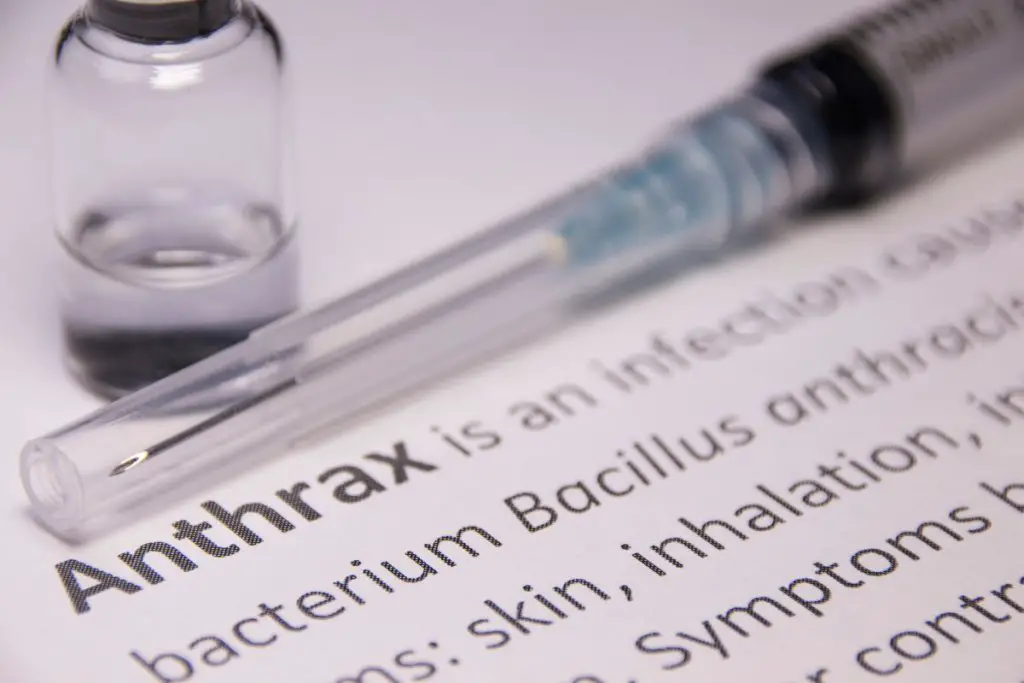Anthrax in cattle is caused by naturally occuring bacteria whose spores can live for more than 50 years. Prevention via vaccine is often the best protection since treatment generally requires culling of the herd.
It can be terrifying to observe your herd falling ill and dying in a short amount of time. Finding answers can be difficult, particularly when you aren’t sure of the cause.
If you’ve lost cattle within hours to a few days, and they have presented with high fever, along with trembling or staggering and convulsions, Anthrax may be the cause.
This article will help you understand what Anthrax is, how to recognize it, and how best to prevent infection in your cattle and treat those who have been exposed to it.
Table of Contents
Causes
Anthrax stems from a naturally occurring spore-forming bacteria called Bacillus anthracis. This disease affects warm-blooded animals (including humans) and is particularly deadly to ruminants and herbivores such as cattle, who have no natural resistance to it.
The incubation period can last between 1 and 17 days, depending on the method of transmission and the susceptibility of the infected party.

Infected animals that have low resistance such as goats, horses, mules, and cattle usually suffer an acute to peracute reaction, dying between 2 hours and 3 days after exposure.
Carnivores and omnivores have been found to have some resistance to this infectious disease, though they are also at risk of suffering serious illness and/or death.
Life Cycle of Anthrax
Anthrax bacteria can be found in a vegetative state or a spore state. The vegetative form which grows within infected animals is the type that causes the disease, and it also produces and releases spores upon the death of the host if exposed to oxygen.
For this reason, infected carcasses suspected of anthrax should be properly disposed of. If necropsy is allowed, or if the body is not disposed of, spores will be released into the environment.
Anthrax spores can live in soil for more than 50 years, are resistant to disinfectants, and are able to withstand extreme weather. Anthrax can survive in boiling water and remain active even if frozen.
Once spores are inhaled or consumed by an animal, these spores revert to the disease state, completing the life cycle.
Methods of Anthrax Exposure
There are three primary methods of contracting this animal disease: cutaneous, ingestion, and inhalation.
Cutaneous Anthrax
Anthrax bacteria can enter the body through contact with cuts or skin abrasions.
When it infects an animal or human by this method, a skin lesion will form.
Similar to a mosquito bite, it presents as a raised, itchy bump. Unlike a mosquito bite, it will then form a blister, and then morph into a painless ulcer that has a black center.
Cattle or people may be infected this way and present with other symptoms of anthrax poisoning along with the tell-tale blister.
Humans most often contract cutaneous anthrax by handling animal products such as leather, hides, and wool of infected animals or handling infected carcasses. There is a twenty percent death rate for cutaneous anthrax that is left untreated.
Ingestion Anthrax
Grazing animals are most at risk of ingesting Anthrax spores by eating plants or matter that has active spores which can then enter the gastrointestinal tract and revert to an active anthrax intestinal infection.
In humans, eating uncooked meat from an animal who died of anthrax, or consuming milk from an infected animal can lead to ingestion anthrax.
Inhalation Anthrax
Cattle that are grazing are more likely to inhale spores that may be in the ground or on plant matter that is out in the pasture. Both inhalation and ingestion are the most common methods of infection for cattle and other ruminants.
Anthrax spores typically remain low to the ground and do not “hang around” the air so it is unlikely for inhalation to occur in humans unless they are handling infected carcasses.
Symptoms
Clinical signs in cattle of an Anthrax outbreak include:
- Lack of eating
- Mood swings
- Swollen lymph nodes
- High Fever
- Difficulty breathing caused by edema in the lungs
- Convulsions
- Erratic movements
- Bloody discharge from the body
- Death
Anthrax infection in cattle often results in sudden death without presenting an opportunity to treat it. However, early intervention with antibiotic treatment may save an animal if caught early enough.
If an outbreak occurs, it is likely to see many Anthrax symptoms developing within a herd.
For animals that die from the disease, it is common for them to expel blood from natural body openings. Bodies often will decompose at a faster than normal rate and may swell as gas builds inside the body. Rigor mortis often will not occur.
Signs of anthrax in humans initially present as cold or flu-like symptoms within 7 days of exposure but will progress into severe breathing issues and shock, followed by death if not treated. The Center for Disease Control and Prevention (CDC) recommends serological testing for humans who may have been exposed.
Prevention and Treatment
Outbreaks of anthrax are often deadly to infected animals, and thus are an important matter of public health and animal health.
Livestock producers should be aware that cases of Anthrax are a reportable disease as they are a biosecurity risk in the United States and many other countries throughout the world.
The best method to prevent your cattle from becoming infected is by providing the anthrax vaccine prior to any exposure.
Luckily, vaccination is highly effective and the livestock anthrax vaccine can provide protection for cattle within 14 days of injection.

If your herd has already been exposed, treatment of the disease in cattle includes antibiotics such as penicillin and oxytetracycline, or ciprofloxacin. Prompt treatment is critical as the disease progresses quickly.
Management methods include quarantine for any exposed animals, removal from the land where they were exposed, vaccination of healthy animals that have not been exposed, and prompt treatment. To prevent the spread of the disease, bedding or other materials found near infected animals should be incinerated, and bodies of dead animals should be cremated.
How Common Is Anthrax?
Anthrax is relatively uncommon in many countries but outbreaks can still occur if environmental conditions allow for the spores to be exposed.
Anthrax is more common in Eastern Europe, the Middle East, Asia, and parts of Africa although it has also been known to appear in Texas and areas of the American southwest.
Anthrax is most likely to occur in nitrogen-rich, alkaline soil that experiences both rain and drought but maintains temperatures higher than 60 degrees Fahrenheit or 15.5 degrees Celsius.
These optimized environmental conditions allow for hibernating spores to become infectious. If your farm has conditions such as these, or Anthrax has occurred in the past, it is important to continually vaccinate your cattle against it.
